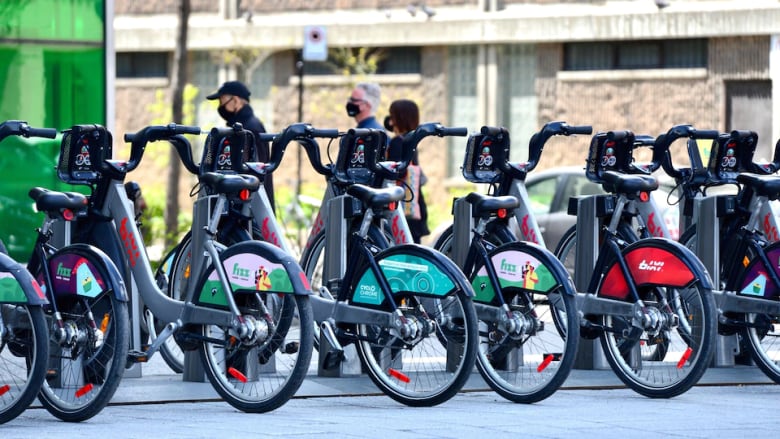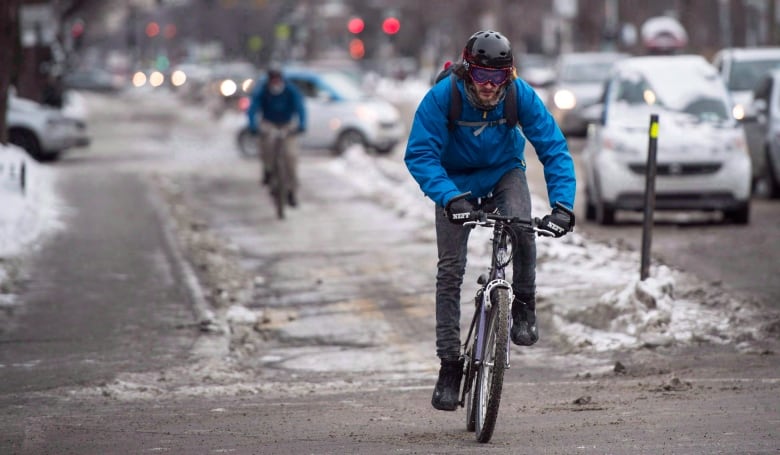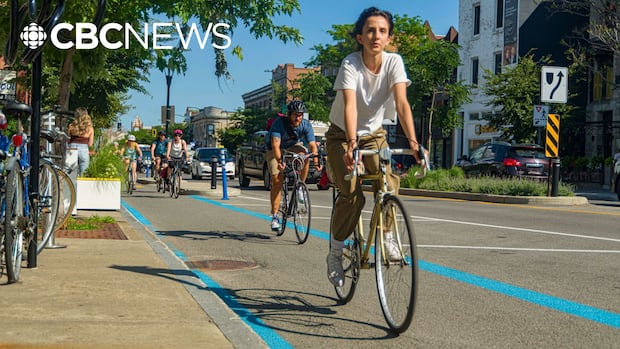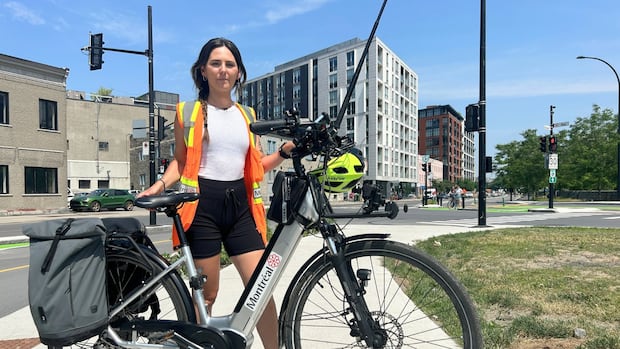
Sia Spanoudakis’s parents have found it harder to get around since a protected bike path was installed in front of their house in Montreal’s Parc-Extension neighbourhood last year.
To make room on Querbes and Ball avenues, the city removed 250 parking spots, including her father’s disability parking spot which was moved to a nearby cross street.
Spanoudakis’s father, Emmanuel Spanoudakis, is 92 years old and her mother has mobility and cognitive issues.
If he has to drop off groceries or help his wife get inside, Spanoudakis said her father has to stop illegally on the bike path and then go park.
And in the winter, it’s not possible to pull up and stop because of the way the snow is cleared on the path.
“My parents are afraid to leave the house,” said Spanoudakis. “It’s caused a sense of isolation, especially in the winter months because even though they have a handicap parking spot on a cross street, people park there out of desperation.”

The revamped bike lanes ignited a major rift last year. It’s one example of clashes between some residents and municipal officials as protected bicycle lanes are installed in neighbourhoods outside of central Montreal.
At its height, thumbtacks were thrown on the bike lanes in Parc-Extension and police were called to monitor the duelling protests in front of the borough’s offices.
Growth took off after Bixi
Vélo-Quebec president Jean-François Rheault says cycling — and the accompanying bike paths — have long been polarizing in Montreal.
The first phase of the city’s bike network began in the 1980s and focused on linking parks.
Not much changed until 2009, with the arrival of Bixi, the city’s bike-sharing program.
Suddenly, Rheault said there was an explosion in the network: mostly painted bike lanes or “sharrows” where cyclists share the street with cars.

“It was relatively easy to do. You put some paint on the ground and it was helping cyclists to have some space,” said Rheault. “But it did not necessarily achieve the level of safety, or perceived safety, that people need to do a modal shift.”
By the end of former mayor Gérald Tremblay’s tenure in 2012, the city said the cycling network in Greater Montreal totalled 630 kilometres.
An additional 220 kilometres were added during Denis Coderre’s time in office.
“When Gérald Tremblay brought Bixi in, there were many cartoons of him on a bicycle and there were also many cartoons of Denis Coderre on a bicycle,” said Rheault.
Despite criticism that the island of Montreal has been overrun with bike paths since Projet Montréal came to power, Mayor Valérie Plante’s administration has only added another 220 kilometres since 2017, bringing the cycling network to a total of 1,065 kilometres.
The difference? Better infrastructure. Those additions were higher quality, protected lanes on busier and larger arteries, said Rheault.
The most notable example is the St-Denis Street portion of the Réseau express vélo (REV) in the Plateau-Mont-Royal borough.
This type of bike lane helps people feel safe while they are cycling and it’s also easier to maintain yearlong. But it hasn’t come without criticism.
Montreal Mayor Valérie Plante is often seen as starting the city’s pro-bicycle transition. But efforts to create major cycling infrastructure projects began long before her administration. And they’ve often caused tensions and conflict.
“We need to remove a lane or remove a lane of parking,” said Marianne Giguère, the city’s executive committee member responsible for active transportation. “It’s a lot harder to do. It’s harder to explain. It’s harder to implement.”
Although there was a lot of outcry from businesses during construction, she said many have now welcomed the changes the REV has brought to St-Denis. She believes some pushback is inevitable during these changes.
Rheault said the next challenge for the city will be tackling large-scale projects more quickly so it can minimize the impact on businesses and the “normal” operation of the city.

Several recent additions, such as the bike path on Terrebonne Street in Notre-Dame-de-Grâce (NDG) and plans to build a protected bike path on Henri-Bourassa Boulevard in the Saint-Laurent borough, have been met with resistance.
“There isn’t an everybody wins scenario,” said Dónal Gill, a professor of political science at Concordia University. “There’s gains and losses and so the car crowd, for want of a better term, always felt that bike lanes were deliberately punitive towards them.”
However, Giguère thinks the city has learned from what happened on St-Denis and has spent more time consulting with residents and businesses before protected lanes are introduced.
Seeking input from residents
In Mercier–Hochelaga–Maisonneuve, Ensemble Montréal Coun. Alba Zuniga Ramos said some tenants with mobility issues couldn’t get Handi-Transit for a couple of months because of the way the bike lane was built in front of their building.
The problem was eventually fixed, but the municipal Opposition’s transportation critic said it could have been avoided by listening to residents.
“There’s a lot of work that has to be done when it comes to improving the cohabitation between cyclists and car owners and different people who use our streets,” said Zuniga Ramos.
In Parc-Extension, many residents rely on their cars to commute to work and take care of their families.
Although the city held an information session about the changes, Spanoudakis said it felt like a done deal.
“They missed the opportunity for citizens to have their input,” said Spanoudakis. “Why did you choose this street versus another? What other options did you consider?”
She helped launch a fundraiser that gathered enough money to retain a lawyer. The group, now called Coalition for Democracy Montreal, is in the process of suing the city.
Ariane Garon has the unique job of riding along all of the city’s bike lanes to get a handle on what shape the network is in.
Spanoudakis said the momentum has spread beyond their neighbourhood to include Ahuntsic–Cartierville and NDG which are also grappling discontent about what some residents see as a lack of consultation over protected bike lanes.
She also laments what she see as a lack of transparency in how many people use these paths.
According to Villeray–Saint-Michel–Parc-Extension spokesperson Rachel Vanier, the borough did not set a minimum volume of ridership on Ball Avenue and there are no counters in place. She said the aim of that path was to connect the neighbourhood to the wider cycling network.
However, Vanier said there are counters installed on the Querbes Avenue path, which counted cyclists between 7 a.m. and 7 p.m. between May and August at Jarry and St-Roch streets.
Between 550 and 730 bicycles were counted each day. Around supper time, it counted up to 120 bikes per hour, Vanier said in an email.
‘When you build it, they will come’
Despite the ongoing tension between different users, the city’s bike network is the envy of Toronto cyclists, said Albert Koehl, co-ordinator of the Toronto Community Bikeways Coalition.
By the end of 2027, Projet Montréal plans to add an additional 200 kilometres of separated cycling lanes.
That kind of commitment is in stark contrast to Ontario, which is considering legislation that would require municipalities to ask the province for permission before it installs bike lanes. Premier Doug Ford has also promised to rip other bike lanes out.
“It’s a real paradise compared to Toronto in terms of cycling infrastructure,” said Koehl. “We no longer necessarily mention Copenhagen or Amsterdam. We mention Montreal.”
Rheault believes one of the advantages Montreal has over cities such as Toronto is a robust cycling culture.

“Even if we compare ourselves to Vancouver, our ratio of men to women cycling in Montreal is much closer to 50/50,” said Rheault. “We see all types of riders, people going to school, people going to work, you know, people wearing a suit, people doing cycling as a sport.”
Giguère said the city’s goal is to provide people with a choice.
“You don’t evaluate the need to build a bridge by looking at how many people are trying to swim across the rapids,” said Giguère. “When you build it, they will come.”

